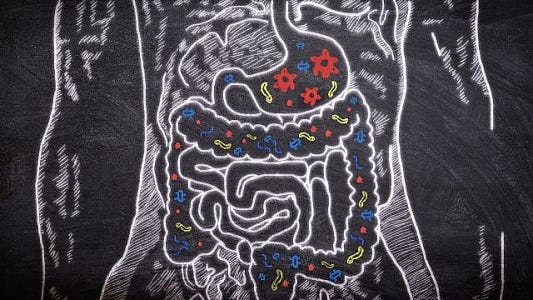Navigating the GLP-1 Options for Weight, Glucose Management & Beyond
Pharmaceuticals vs. Supplements vs. Diet
INTRODUCTION
There is no surprise that your diet, both in terms of composition and volume, is directly linked to weight gain. Nevertheless, considering the pervasiveness of obesity and/or overweight (75% of the USA population) we are still deciphering the best approaches to achieving optimal weight. For ages, the macronutrient nutritional approach has been focused on protein and fiber as being beneficial, with fats and carbohydrates as the “bad guys”. That has a role, but if that focus alone was incredibly effective then the problem would not exist in the current magnitude. Both the message and its rationale have limitations hence we must do better.
Certainly, the link between excessive sugar and insulin insensitivity is a driver for poor health including obesity. This is emphasized by the clear benefits of GLP-1 drugs that were developed for diabetes and superior glucose management ( Discovery of Semaglutide)) However, subsequently we note that their impact on weight loss can be profound. As a result, claims for this drug class have switched their focus to weight, downplaying the impact of liver function and glucose management ( Semaglutide reduces cardiovascular risk in obese but non-diabetic individuals ) This redirection of GLP-1 drug use is in part a marketing decision, but certainly reflects the dramatic results on weight loss, a potentially much larger fiscal market.
This trend demands that we reflect on what is exactly GLP-1 and what does it do?
GLP-1 is a hormone that the body releases with meals. In essence, it communicates with the brain to affirm that you have eaten enough, so put down the knife and fork and STOP EATING. The more technical term is satiety ( Hunger and Satiety Signalling ) Additionally, GLP-1 is connected in a merry dance with Ghrelin, another hormone controlling eating, but in this case ghrelin drives hunger.
Changing the landscape of GLP-1/Ghrelin ratios affects the feelings of hunger and satiety and as a result how many calories are ingested. When one responds to the satiety signal mediated by GLP-1, less food (calories/joules) is ingested. Note that for those that eat rapidly, this concept may be a less effective as the release of the hormone takes time. Plus, you must respond to the satiety signal. Bulldozing past the fullness signal and continuing to eat will limit the impact.
I am here at an “All you can eat buffet” and I intend to take full advantage.
On the flipside, if one consumes a decent amount of water with the meal (or another low-calorie beverage), the gastric distension associated with this volume will enhance the satiety and fullness response. Eating slowly with fluids is a desirable, effective behavioral component to the weight loss plan. Additionally, this is not simply a hormonal response as the enteric nervous system is also signaling the brain that you have eaten enough, particularly in reference to gastric distension.
Additionally, GLP-1 stimulates the release of insulin and its effectiveness in response to meals ( GLP-1 and Insulin ) Here the purpose is to manage the meal-generated glucose load as insulin drives the warehousing of blood glucose into tissues. Further, GLP-1 slows down gastric emptying, which further helps in lowering the systemic impact of a “sugar rush”.
One may not expect direct impacts on the cardiovascular system with GLP-1, but there are significant benefits there as well. Lowering of blood lipids, or more specifically lowering triglycerides and LDL in favor of HDL (the good cholesterol transport protein) are a desirable outcome. These results reflect actions on the liver. Lowering of blood pressure has also been noted. Looking beyond weight and glucose, GLP-1 possesses the hallmarks of a cardiovascular health tonic ( GLP-1 Benefits for Cardiovascular Health ).
Hence it is not surprising, given the dominance of obesity and diabetes in various populations, that pharmaceutical companies have developed a range GLP-1 mimics (agonists to the GLP-1 receptor) called semaglutides to change the status quo. However, there are also other options, related to nutrition and the microbiome. This article is meant to help one decipher how to manage this process, define what are your options and guide one to a healthier state of balance.
It is important to note that from a societal perspective, the problem is pervasive and massive. Nearly 40% of the global consumers list weight management as a primary health concern. As a result, the market size for pharmaceutical approaches to weight management is projected to reach $105 billion by 2030.
Where there are unmet consumer needs, opportunities for innovation arise.
That opportunity is not limited to the biotechnology and pharmaceutical industries as 60% of individuals contemplating a pharmaceutical approach would consider a natural alternative. The primary drivers for this interest are cost, adverse events & challenging side-effects, and rebound effects associated with pharmaceuticals.
Let’s explore these options.
Pharmaceutical Approach
A variety of semaglutide options (GLP-1 receptor agonists) exist in what is becoming a rapidly crowded pharmaceutical market. The industry loves to mimic the success of other companies as exemplified by the various biologics that target cytokines. Semaglutide forms now include ingestibles as well as injection products.
These drugs enjoy a plethora of publicity, with celebrities showing off results, not to mention influencers and the attention offered by the lay press. One of the testaments as to their popularity is that semaglutides have become the number one product in Costco, a no-frills warehouse-like store.
Whilst the effectiveness of these pharmacological approaches is quite remarkable, for some the side-effects are substantial. The more common side-effects deal with gastrointestinal issues (nausea, digestive complaints) as well as non-digestive issues like muscle mass loss and fatigue. These events may lead consumers to abandon the programs.
However, cessation of semaglutide therapy comes with a price. One common feature is rebound weight gain. Indeed, this rebound weight gain may be substantial. For example, gaining 66% of the weight that had been lost, has been reported (Rebound weight gain ).
This quite predictable result is concerning, not only for the lost gains in weight management but also the costs that were associated with the therapy. The pharmaceutical industry may not be too concerned with this problem as it may mean that consumers will be reluctant to leave the program, and if they do, they well be inclined to return. In general, the pharmaceutical industry approach is not focused on establishing a health status to where drug therapy is no longer required. Rather the strategic business approach for pharmaceuticals is to address the issue in a manner that demands sustained treatment, thereby enjoying its associated sales.
Specific Nutraceuticals
One alternative approach that is gaining attention are nutraceuticals. These are usually botanicals, although food-inspired options exist as well. There is most certainly a clamor to ride the public interest and awareness of semaglutides with an alternative that should have limited side-effects, especially when compared to the pharmaceuticals.
The botanicals that have received the greatest attention (through exuberant marketing efforts) are berberine and green tea. Berberine has been used for liver health and glucose management for quite some time. It is thought to stimulate GLP-1 release via activation of bitter taste receptors (Berberine and GLP-1 ). Despite the promotion of this botanical as an alternative, questions remain as to the effectiveness in weight management. Berberine may be better suited for liver function and insulin sensitivity.
Green tea is a botanical that, through its catechin content, has been linked to metabolic enhancement and weight loss. It does appear to stimulate GLP-1 release, but what is less clear is if this is the core driver of its benefits. Further it is unclear as to how sustained these effects are, the doses required as well as its effectiveness. Like berberine, green tea has received a lot of hype as Natural OzempicÒ, which are misleading and confusing for the public as they are NOT mimics of GLP-1. None of the natural alternatives directly interact with GLP-1 receptors as do pharmaceuticals. Rather, the concept that they exploit is the ability to produce elevated endogenous levels of GLP-1, to produce a more profound satiety response to eating.
There is one natural approach stands out for the depth of its scientific support, and it is a botanical combination of lemon verbena and hibiscus, marketed as Metabolaid. With research on metabolic health starting some 20 years ago, they launched their first clinical trials for enhanced GLP-1 production a decade ago, around the same time as when the semaglutides were first starting their clinical R&D program. There are several features with Metabolaid that I like:
· Elevated levels of GLP-1 are well controlled in that food per se raises GLP-1 secretion, and MetabolaidÒ takes those levels and elevates them further.
· It demonstrates the full range of cardiometabolic benefits as well as weight loss, including activation of the metabolic switch AMP kinase.
· The weight loss is at an enviable pace, building month on month as the body recalibrates its hunger/satiety setting.
· The reductions in LDL, TGs and cholesterol are as expected for a GLP-1 action, and impactful for these pervasive conditions.
· Improvements in HbA1c are consistent with actions related to improvements in insulin sensitivity creating a smoother, balanced management of blood glucose levels.
The collage of clinical studies behind Metabolaid affirms the desirable benefits of elevated GLP-1 production (reduced hunger and cravings), but yet clinically avoids the complications and side-effects of pharmaceutical approaches with GLP-1 receptor agonists ( Clinical Studies on Metabolaid ). Raising your own production of GLP-1 rather than a drug-associated strong stimulation of GLP-1 receptors has appeal. In essence it is a kinder, gentler approach guiding your body to heal itself.
While the Metabolaid research studies do not examine the impact of treatment cessation, consumer experience suggests that a strong rebound in weight gain does not occur. That may be confusing to many, although eminently desirable. My interpretation centers on the physiological concept of HOMEOSTASIS.
Homeostasis is the body’s response to perturbations where it uses various regulatory pathways (hormonal, neural, metabolic etc.) to return a state that has been disturbed back to its original setting. It reflects the considerable power of your own complex, multi-factorial balancing acts.
Blood pressure is a good example of this. For various reasons when blood pressure becomes too low or too high, systems are evoked to return blood pressure back to normal. Upon achieving that goal these homeostatic systems then return to a less-involved guardian state, ready to act again as needed.
When you think about it, that is ideal for a weight management program. To avoid rebound, you want all systems to recognize that this new setting, this new balance point, needs to be supported. It is the new you. In terms of weight, usually obesity onset is slow and gradual and as such the homeostatic forces are slowly adjusted to an ever-changing new balance point. In other words, they are never evoked to return one to the normal, healthy weight. The time taken is akin to a Trojan Horse avoiding the physiological responses designed to maintain the status quo.
The ideal goal is to restore that homeostatic balance point to help maintain a healthy weight and glucose management system, where homeostasis is actively maintaining this new weight position. By contrast, the pharmaceutical approach has no impact on homeostasis adjustments and upon cessation there is an active physiological response designed to return weight to its elevated pretreatment level.
The homeostatic adjustments that are evoked with natural product approaches, but absent with semaglutides, is a fundamental reason for their divergence in rebound phenomena. This reflects the differences in mechanisms of action. Semaglutides are potent agonists for the GLP-1 receptor whereas natural product approaches are designed to amplify the secretion of GLP-1 in response to food.
How is this re-alignment of homeostatic processes achieved?
One intriguing aspect is the microbiome. We know that a disturbance of the gut microbiome, creating a new state with an unbalanced profile of microbes, is a driver for weight gain. A decade ago, the New York Times drew the public’s attention to this with a comprehensive article calling antibiotics “Fat Drugs” ( Antibiotics - the Fat Drugs ). Observations that antibiotics promoted weight gain were well known early after their commercial use. Implemented in the meat industry, as well as by pediatricians for slow growing children, antibiotics were reclassed as “growth promoters”. The precise reason was not readily apparent at the time, but their implementation continued for decades. However, we now appreciate how devastating the actions of antibiotics are on the profile of a healthy microbiome and how a dysbiosis (dysfunctional microbiome profile) promotes weight gain.
Obesity should be regarded as an infectious disease.
We know this because the obese phenotype can be transferred with the wrong gut microbes ( Obesity transferance with Gut Microbiome transplants ) If one was to inoculate of lean individuals with fecal microbiome transplants from an obese donor, then the recipient takes on the phenotype of obesity within months. This action can cross species and is commonly encountered when fecal microbiome transplants are used to clear infections with C. difficile. Transplanting the gut flora from an obese donor to a lean, albeit C. difficile infected recipient, will clear the infection but within months the recipient takes on the obese phenotype of the donor ( Obesity & the Gut-Microbiota-Brain Axis). The opposite is also true, with obesity being managed by fecal microbiome transplants from lean individuals.
The profile of the gut microbiome is a major determinant of the weight status of an individual.
If the gut microbiome is such a critical component to correct weight, and if dysbiosis is concurrently so pervasive in society, then one could postulate that any effective treatment approach should positively impact the profile of the gut microbiome.
For Metabolaid this is a core feature of its benefits. It has the ability to raise levels of “good bacteria” like Prevotella, Bifidobacter species and importantly, Akkermansia muciniphilia. In essence this is a prebiotic action, amazingly registered at a low dose of 500mg (fiber-based prebiotics usually require a 20x greater dose). This improvement in the microbiome profile is associated with increased production of short-chained fatty acids (SCFAs) like butyrate. A process that is linked to improved mucin production as well as … stimulation of GLP-1 release ( SCFA stimualtes GLP-1 production). Here we can see the critical points of interaction between the profile of the gut microbiome affecting hunger/satiety and weight management
Do all prebiotics share this ability to enhance GLP-1 production?
The science is not there yet but there are other supporting studies. A prebiotic action with increased relative levels of Akkermansia is also noted with a resistant starch, SolnulÒ, made from potatoes ( Solnul and Akkermansia ). However, research linking SolnulÒ to elevated GLP-1 levels is not available to date. The redefining features of prebiotic actions on the gut microbiome is consistent with the steady improvements on weight balance over time (month on month) and concept of re-establishing the homeostatic balance point to negate rebound weight gain.
One other element worth noting is that Akkermansia levels are quite elevated in Centenarians ( Akkermansia & Gut Microbiome in Centenarians). This suggests, by association, that Akkermansia is a pro-longevity microbe ( Longevity and the Gut Microbiome Profile). It also makes sense that robust Akkermansia levels are linked to elevated GLP-1 secretion ( Akkermansia stimulates GLP-1 Secretion), as all the Centenarians that I have met have a lean profile.
Do obese Centenarians exist?
Food
We have discussed how food evokes the secretion of GLP-1, to produce a satiety response which may in part be mediated by sensory afferent nerves given that GLP-1 is rapidly inactivated by the enzyme dipeptidyl-peptidase IV ( Physiology of GLP-1). However, are all foods equal in this action? It appears that foods high in protein, fiber and healthy fats are preferable for stimulating GLP-1 release. However, as noted above, whilst these have been mainstay approaches to the dietary management of obesity, these dietary approaches alone are not enough.
There is a lot of research ongoing to define what specific elements within food can be used to augment the secretion of GLP-1, including peptides. Neural pathways should not be ignored as they drive the systemic responses given the short half-life of GLP-1 (note the GLP-1 pharmaceutical mimics are effective because of designs to limit the degradation of GLP-1. Given that the diet can have massive influences on the gut microbiome, a dietary approach that is directed to the microbiome has substantial appeal for long term health including the management of weight and glucose.
CONCLUSION
These are interesting times when a new approach challenges how we manage health. Certainly, the pharmaceutical approach has created spectacular interest in GLP-1 mimics as effective treatments for diabetes and obesity. On the other hand, nutraceutical approaches including actions on the microbiome may offer an affordable alternative, one that is associated with a lower incidence of side-effects and complications like rebound weight gain. This includes leveraging a healthier dietary profile to reset the homeostatic balance points that regulate hunger/satiety and metabolism.
The fascinating aspect of optimizing GLP-1 functionality is that the benefits are broad, covering major health problems for society – obesity, diabetes and cardiovascular health.
That is an impressive trifecta.








Thank you, Dr. Miller for another very informative article!!